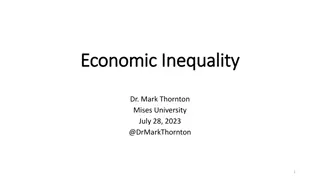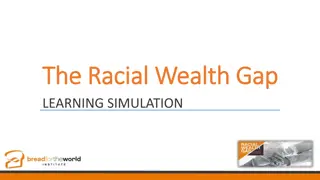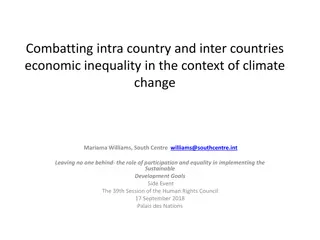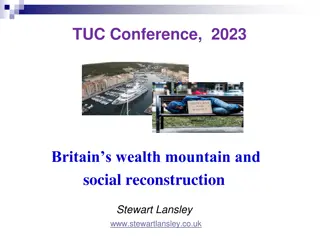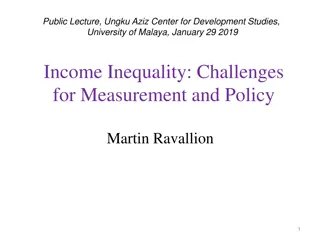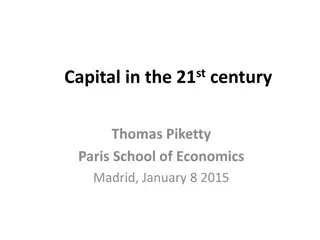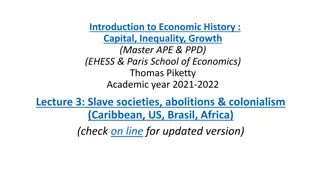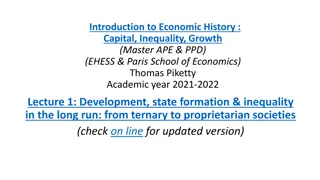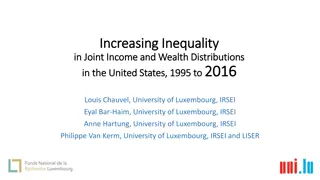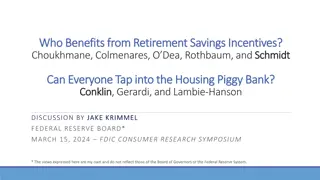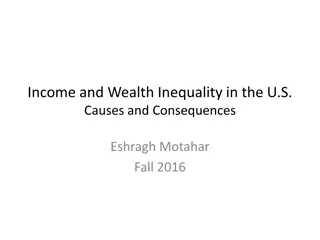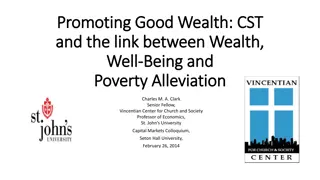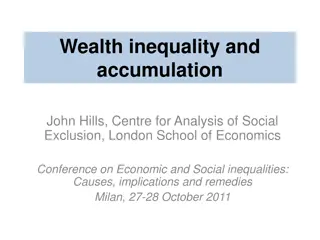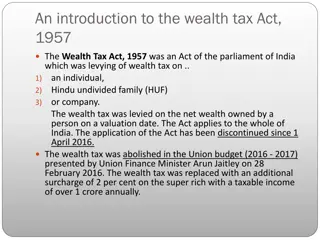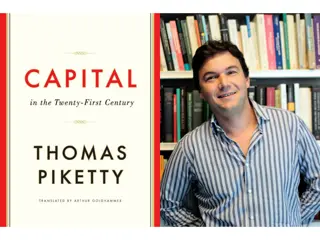Global Wealth Inequality Dynamics: Insights from Piketty's Lecture
Explore the complexities of global wealth distribution and its impact on inequality through Piketty's lecture on the regulation of capital. The discussion delves into the challenges of studying wealth inequality on a global scale, factors influencing wealth distribution, data comparisons between university endowments and individual wealth, and insights on sovereign wealth funds' varying returns and transparency issues. Gain a deeper understanding of how global economic forces shape wealth gaps and investment strategies.
Download Presentation

Please find below an Image/Link to download the presentation.
The content on the website is provided AS IS for your information and personal use only. It may not be sold, licensed, or shared on other websites without obtaining consent from the author. Download presentation by click this link. If you encounter any issues during the download, it is possible that the publisher has removed the file from their server.
E N D
Presentation Transcript
Economics of Inequality (Master PPD & APE, Paris School of Economics) Thomas Piketty Academic year 2014-2015 Lecture 7: The regulation of capital and inequality (Tuesday November 25th2014) (check on line for updated versions)
The world dynamics of the wealth distribution It is more and more difficult to study wealth inequality at the national level: one needs to take a global perspective In the long run, in case r g at the global level, then world wealth inequality will Other important force: in today s global capital markets, r might well vary with wealth level w, i.e. r=r(w) (scale economies in portfolio management and/or risk taking) ( perfect k market: everybody receives r = world FK) See data from Forbes rankings and university endowments on varying r = r(w)
Data on university endowments: much higher quality than Forbes data on individual wealth 800 universities in the US, with average endowment 500 millions $: aggregate endowment 400 billions $ in 2013 This is << than global wealth billionaires ( 5500 billions $, i.e. 5,5 trillions $ = about 1,5% of world wealth 350-400 trillions $) But at least universities provide very detailed data on their porfolio strategy and observed rates of return
Returns on sovereign wealth funds (SWF) seem to very from very high (Abu Dhabi: 700 billions = twice as large as all US universities endowments combined) to relatively low (Norway, Saudi Arabia: less risk, huge US public debt component: economics or politics?) But data is relatively low quality: very little transparency All SWFs: about 5,5 trillions ( global billionaires), including 3,5tr for oil countries and 2tr for non-oil countries (1tr for China) Other reason for divergence: different saving rates, e.g. because of different pension strategies, can lead to huge net foreign asset positions ( 1=s1/g > 2=s2/g), quite independantly from r > g; but of course low g and r > g can amplify initial NFAs
Is oligarchic divergence (rise of global billionaire wealth: billionaires own a rising share of global wealth) or international divergence (rise of foreign wealth: countries own other countries) more likely? Both can happen. But international divergence is relatively easier to deal with (capital controls). Oligarchic divergence = harder to deal with, because it requires detailed information on individual wealth levels and strong international coordination. As of today, offshore wealth is enough to turn rich countries NFA from <0 into >0; could rise in the future See Zucman 2013, The missing wealth of nations: are Europe and the US net debtors or net creditors?
Regulating capital in the 21st century During 20c, huge rise of tax revenue (from 10% of 40-50% GDP) = rise of the modern fiscal and social state, partly as a response to high inequality generated by free market capitalism This great leap forward is not going to happen again: during 21c, tax revenue is likely to stabilize (or decline if rising tax competition), not to rise again to 70-80% GDP The 21c challenge is not to make govt bigger (at least in rich countries), but to make them more efficient, both in terms of public spendings and fiscal and regulatory system
Challenges for 21c tax system The ideal fiscal trypyic: income tax, inheritance tax, wealth tax Progressive income tax: basic pillar for financing public goods and social spendings (together with social contributions); progressivity at the very top is critical not so much to raise revenue, but mostly to keep top labor incomes and rent extraction under control Theory: see Optimal taxation of top labor incomes , AEJ 2014 (see also Slides) History: see graphs; very chaotic and unpredictable evolutions; depend upon perceptions of fairness, national identities; hard to predict future evolutions
Progressive inheritance tax: in a context of rising importance of wealth and inheritance, this is an important policy tool to restore (or at least increase) equality of opportunity in a world with two- dimensional inequality (inherited wealth vs labor earnings) Theory: see A Theory of Optimal Inheritance Taxation , 2013 History: see graphs; also chaotic and unpredictable; downward trend in top rates due to globalization (repeal of inheritance tax in small countries) or political capture?
Progressive wealth tax: with imperfect k markets, progressive inheritance tax is not enough; also, independantly of inheritance, wealth can be a better indicator of ability to pay than income Theory: see Rethinking capital and wealth taxation , 2014 History and future: in order to counteract high r for top w, top rates would need quite large (5-10% rather than 2-3%? = a big difference with previous wealth taxes) But the main objective behind wealth tax is to deliver international financial transparency and global wealth registration: automatic exchange of information between countries, world registry of financial assets, public statistics on wealth, etc.; and then we ll see which tax rates are optimal
More generally: taxation is the most civilized form of regulation (i.e. it allows for efficient and transparent redistribution and intervention, while preserving international economic openness and competitive forces) But taxation is certainly not the only form of regulation: various forms of capital controls or political controls or participatory governance or migration policies or inflationary policies can also be used, and are used (China, Russia, Europe, US, ..) Among these non-tax tools, inflation can be quite useful to reduce public debt; but it is like a tax on low wealth, so it is definitely not as good as a progressive wealth tax) Historically, land reform also played important role (see e.g. Korea- Taiwan vs Philipinnes, Asia vs Latin america); in a way, progressive capital tax is like a permanent tax reform By producing more transparency, it can also contribute to more democratic property relations and participatory governance





